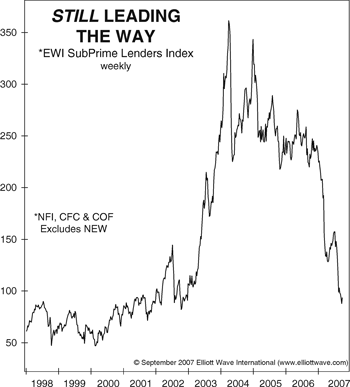Hey, what about this comment and chart from the March 2005 issue of The Elliott Wave Financial Forecast? The forecast is from so far back that it’s off the radar of those that are now doubling back to get a handle on where subprime went off the tracks. It’s taken an incredible 30 months for the headlines to focus on the initial phase of the downturn – this suggests a truly explosive reversal as only a really big bomb would have such an extremely long-fuse. It also suggests that EWFF was probably right to place the subprime problem at the forefront of a much bigger breakdown for the markets and the lending environment.
This is the most important aspect of the subprime problem, but somehow, it is the part that most financial participants cannot or will not accept. Alan Greenspan’s experience and revised outlook based on the recent proliferation of the subprime disaster is a perfect example. Greenspan now acknowledges his underestimation of the subprime problem saying, “I really didn't get it until very late in 2005 and 2006.” He even adds. “We know where it's going. We have never had the capacity to defuse a bubble, and I suspect the reason is that until we essentially reach the climax of euphoria, the speculative fever doesn't break. But when it does, it turns on a dime.” Just such a turn into the larger economy occurred with the credit market meltdown in July and August (see collage of headlines on page 2 of the August issue of The Elliott Wave Financial Forecast). But no matter how persistently and clearly the “turn on a dime” shows itself, Greenspan continues to play down the potential for a protracted economic contraction. On Monday, for instance, he told the Associated Press that the chances of a recession is less than 50%.
This chart of the subprime sector is a picture of much higher odds:

The updated EWI Subprime Index is slightly different than the original version as one member, New Century Financial (NEW), is no longer in business. Another, Novastar (NFI) is down from almost $300 to $8, and may not be long for this world, either. Countrywide (CFC) and Captial One (COF) are basically out of the subprime sector; so this group is probably losing its effectiveness as a subprime indicator. The near complete retracement of the decline to date, however, speaks volumes about the road ahead for the economy and financial markets as whole.
|
